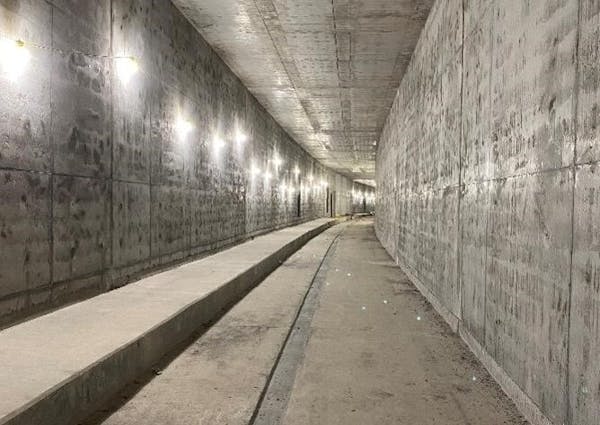The Blue Line light-rail extension between downtown Minneapolis and Brooklyn Park will cost between $2.9 billion and $3.2 billion, according to a new estimate released Wednesday.
"My view is that this is really an important investment — it will have far-reaching economic benefits," said Charlie Zelle, chair of the Metropolitan Council, the regional planning body that will oversee construction of the Blue Line extension project.
The base price is $2.2 billion based on the early design and "known field conditions," but a contingency of 35% to 45% was added to satisfy the line's federal funders and to provide a cushion for unexpected costs, according to a memo to be distributed this week to members of the Met Council.
In estimating the Blue Line extension's cost, transit planners were mindful they'll face a skeptical public, given the $2.9 billion Southwest light-rail line is more than $1 billion over budget, nearly a decade behind schedule and the subject of a probe by the state's legislative auditor. Southwest, currently under construction, is an extension of the Green Line that will connect Minneapolis with Eden Prairie and is the most expensive public works project in state history.
"That's been a lesson for us," Zelle said. With the Blue Line extension, "we did not want to sugarcoat the facts, both positive and negative. This project is different. We are taking an approach that is methodical and prudent, and we're also spending time up front to consider some of the impacts that could be troublesome for the community."
Officials don't expect the bottom line to shift after two additional cost updates on the Blue Line extension are completed later this year as work continues and cities along the corridor and Hennepin County vote on the route.
"There are still a lot of unknowns." said Nick Thompson, the Met Council's deputy general manager for capital projects. "We want to be very transparent with everyone: These are the numbers."
The Blue Line extension will link Target Field in downtown Minneapolis to Brooklyn Park through north Minneapolis, Robbinsdale and Crystal. Service is expected to begin in 2030.
The Federal Transit Administration (FTA) is expected to pay 49% of the cost to construct the 13.5-mile line, with Hennepin County picking up most of the rest, using revenue from a countywide transportation sales tax. Once built, the Met Council will cover the line's operating and maintenance costs, using a different regional sales tax for public transit. About $160 million has already been spent on the line.
The early estimate for the Blue Line extension was in line with what Hennepin County Board Chair Irene Fernando expected. "Local communities benefit with having an accurate estimate," she said. "This is a reasonable and appropriate number."
Hennepin County officials say other federally funded transit projects proposed in Seattle and Los Angeles are more costly per mile. The Blue Line extension is expected to cost about $222 million a mile.
The council also released a preliminary ridership estimate for the line using a federal formula that mixes pre- and post-COVID data from 2019 and 2022, respectively. Average ridership is expected to be between 11,500 and 13,000 passengers a day.
Once the extension begins service, ridership on the entire Blue Line route — from the Mall of America in Bloomington to Brooklyn Park — is expected to be more than 30,000 a day. About half of the people expected to use the Blue Line extension do not have access to a car.
The Green Line, which began service between downtown Minneapolis and St. Paul 10 years ago, has an average weekday ridership of 24,166, according to county officials. Overall ridership on Metro Transit trains and buses increased 16% last year, but is still about 60% of pre-pandemic levels.
"Obviously post-COVID there's been an upward trend in ridership," Thompson said, adding it's unclear when ridership will stabilize.
The Blue Line extension's current route and mode of transportation continues to face opposition. Some residents in Robbinsdale and in the North Loop in Minneapolis say bus rapid transit would be a cheaper alternative and less intrusive.
But, Thompson said, "the current project is a light-rail project. Light rail is the backbone of this system." Bus-rapid transit would not properly serve the corridor since the service is too slow, he said.
Initial plans for the Blue Line extension involved sharing much of the route with BNSF Railway freight trains, but after years of futile negotiations with the Texas-based rail giant, the council abandoned the route in 2020 and started over.
Issues with the public soon surfaced once the council devised a new route, which featured service along W. Broadway in the heart of north Minneapolis, and a stop at North Memorial Health, a major employer in Robbinsdale.
Residents of Lyn Park in north Minneapolis opposed trains traveling along Lyndale Avenue, which they said would split their neighborhood and add noise and possibly crime. The route was then changed to travel through the North Loop from Target Field station to the east side of Interstate 94. Now, a new bridge for light-rail trains is planned for the route straddling the interstate.
The route was further altered after businesses along W. Broadway expressed concern about light-rail traffic on the thoroughfare, and the loss of parking and business before and after construction. Now, the line will travel parallel to W. Broadway along 21st Avenue N.
"The overall cost might feel large, but the benefits to local residents is quite favorable," said Fernando, who lives in north Minneapolis.
Carolyn Parnell, 'trailblazer' who served as Minnesota's first IT commissioner, dies


